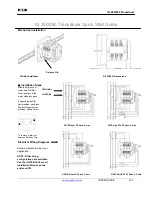
KM15 PRESSURE TRANSDUCER
INSTRUCTION SHEET
Output Type
Excitation
Supply Current
0.5/4.5 V
Ratiometric
5V±.5 Vdc
10mA typ
1/5V
8-32 Vdc
10mA typ
© 2011 Ashcroft Inc., 250 E. Main St., Stratford, CT 06614-5145, Tel: 203-378-8281, Fax: 203-385-0408, www.ashcroft.com
All sales subject to standard terms and conditions of sale. I&M011-10168. Rev. A 5/11
Teflon is a registered trademark of E. I. DuPont
RoHS Compliant
WARNING! READ
BEFORE INSTALLATION
1. GENERAL:
A failure resulting in
injury
or
dam-
age
may be caused by excessive
overpressure, excessive vibration or
pressure pulsation, excessive instru-
ment temperature, corrosion of the
pressure containing parts, or other
misuse. Consult Ashcroft Inc.,
Stratford, Connecticut, USA before
installing if there are any questions
or concerns.
2. OVERPRESSURE:
Pressure spikes in excess of the rated
overpressure capability of the trans-
ducer may cause
irreversible electri-
cal and/or mechanical damage
to the
pressure measuring and containing
elements.
Fluid hammer
and surges can destroy
any pressure transducer and must
always be avoided. A pressure snub-
ber should be installed to eliminate the
damaging hammer effects. Fluid ham-
mer occurs when a liquid flow is sud-
denly stopped, as with quick closing
solenoid valves. Surges occur when
flow is suddenly begun, as when a
pump is turned on at full power or a
valve is quickly opened.
Liquid surges
are particularly damag-
ing to pressure transducers if the pipe
is originally empty. To avoid damaging
surges, fluid lines should remain full (if
possible), pumps should be brought up
to power slowly, and valves opened
slowly. To avoid damage from both fluid
hammer and surges, a surge chamber
should be installed.
Symptoms of fluid hammer and surge's
damaging effects:
• Pressure transducer exhibits an out-
put at zero pressure (large zero offset).
• Pressure transducer output remains
constant regardless of pressure
• In severe cases, there will be no output.
FREEZING:
Prohibit freezing of media in pressure
port. Unit should be drained (mount in
vertical position with electrical termi-
nation upward) to prevent possible
overpressure damage from frozen
media.
3. STATIC ELECTRICAL CHARGES:
Any electrical device may be suscepti-
ble to damage when exposed to static
electrical charges. To avoid damage to
the transducer observe the following:
• Ground the body of the transducer
BEFORE making any electrical con-
nections.
• When disconnecting, remove the
ground LAST!
Note: The shield and drain wire in the
cable (if supplied) is not connected to
the transducer body, and is not a suit-
able ground.
Mounting
The KM15 transducer requires no special
mounting hardware, and can be mounted
in any plane with negligible position error.
Although the unit can withstand normal
vibration without damage or significant
output effects, it is always good practice
to mount the transducer where there is
minimum vibration.
For units with NPT type pressure fittings
apply Teflon
®
tape or an equivalent
sealant to the threads before installing.
When tightening, apply a wrench to the
hex wrench flats located just above the
pressure fitting.
DO NOT
tighten by using
a pipe wrench on the housing.
Noise
For minimum noise susceptibility, avoid
running the transducer’s cable in a con-
duit that contains high current AC power
cables. Where possible avoid running the
cable near inductive equipment.
Shield Wiring
(Cable Termination Only)
Connect the braided shield to the guard
terminal on the reading instrument
(meter, etc.) if available or to ground or to
the power supply negative terminal.
Vent Tube (Cable Termination Only)
The cable will have a clear Teflon
®
vent
tube that's required at pressure below
500 psi to provide atmospheric refer-
ence. The open end should be placed in
a dry area.




















